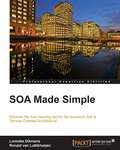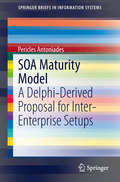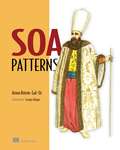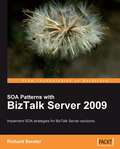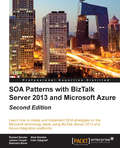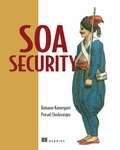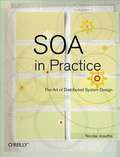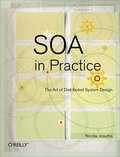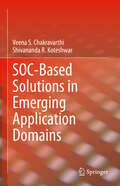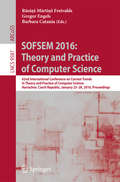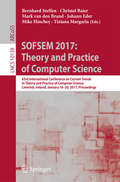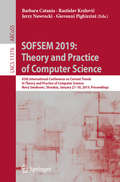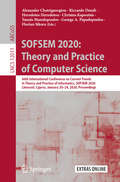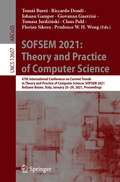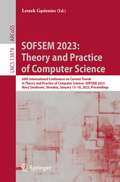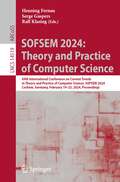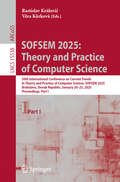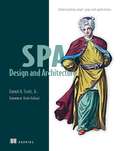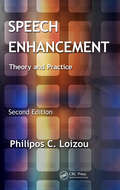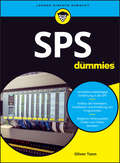- Table View
- List View
SOA Made Simple
by Ronald Van Luttikhuizen Lonneke Dikmans"SOA Made Simple" is a concise and indispensable handbook for finally understanding exactly what Service Oriented Architecture is. Split into three clear sections, in this book you'll learn from both theory as well as step-by-step implementation examples to aid in your understanding of this often poorly- articulated industry term.If you are an architect who wants to be completely clear in your understanding of what SOA is, then this book is essential. In fact, anyone (designer, developer, administrator or team lead) who is implementing or about to implement an architecture in an IT environment should not miss out on "SOA Made Simple". Some previous experience with general software architecture is required, but this guide will tell you everything you need to know about SOA in a clear and easy fashion.
SOA Maturity Model
by Pericles AntoniadesCompanies have long sought to integrate existing Information Systems (IS) in order to support existing and potentially new business processes spread throughout their "territories" and possibly to collaborating organizations. A variety of designs can be used to this end, ranging from rigid point-to-point electronic data interchange (EDI) interactions to "Web auctions". By updating older technologies, such as "Internet-enabling" EDI-based systems, companies can make their IT systems available to internal or external customers; but the resulting systems have not proven to be flexible enough to meet business demands. A more flexible, standardized architecture is required to better support the connection of various applications and the sharing of data. Service-Oriented Architecture (SOA) is one such architecture. It unifies ("orchestrates") business processes by structuring large applications as an ad-hoc collection of smaller modules called "Services". These applications can be used by different groups of people both inside and outside the company, and new applications built from a mix of services (located in a global repository) exhibit greater agility and uniformity. Thus, SOA is a design framework for realizing rapid and low-cost system development and improving total system quality. SOA uses the Web Services standards and technologies and is rapidly becoming a standard approach for enterprise information systems integration. SOA adoption by enterprises has been identified as one of the highest business priorities by a recent Gartner study (Gartner 2007) and enterprises increasingly recognize the requirement for an increased "Service-orientation" and relevant comprehensive frameworks, which will not only help them position themselves and evaluate their SOA initiatives, but also guide them in achieving higher levels of SOA maturity. This in turn, will help enterprises acquire (and retain) competitive advantage over other players in the market who are not (using SOA and thus they are not) so flexibly adjusting themselves to address new business requirements. This book proposes a new SOA Maturity Model (MM) using a Delphi-variant technique and this constitutes one of its distinguishing features because none of the relevant existing works utilized Delphi. Moreover, the fact that the proposed SOA MM supports inter-enterprise setups makes it even more distinct. The newly proposed SOA MM is then used to help the participating organizations position themselves in respect to SOA (current status), guide them to achieve higher levels of SOA maturity, and anticipate their SOA maturity in five years' time. Furthermore, the "local" or "global" nature of the proposed SOA MM is investigated. This is checked firstly against selected expert panel participants and secondly against local business practitioners.
SOA Patterns
by Arnon Rotem-Gal-OzSummarySOA Patterns provides architectural guidance through patterns and antipatterns. It shows you how to build real SOA services that feature flexibility, availability, and scalability. Through an extensive set of patterns, this book identifies the major SOA pressure points and provides reusable techniques to address them. Each pattern pairs the classic problem/solution format with a unique technology map, showing where specific solutions fit into the general pattern.About the TechnologyThe idea of service-oriented architecture is an easy one to grasp and yet developers and enterprise architects often struggle with implementation issues. Here are some of them:How to get high availability and high performanceHow to know a service has failedHow to create reports when data is scattered within multiple servicesHow to make loose coupling looserHow to solve authentication and authorization for service consumersHow to integrate SOA and the UIAbout the BookSOA Patterns provides detailed, technology-neutral solutions to these challenges, and many others, using plain language. You'll understand the design patterns that promote and enforce flexibility, availability, and scalability. Each of the 26 patterns uses the classic problem/solution format and a unique technology map to show where specific solutions fit into the general pattern.The book is written for working developers and architects building services and service-oriented solutions. Knowledge of Java or C# is helpful but not required.Purchase of the print book comes with an offer of a free PDF, ePub, and Kindle eBook from Manning. Also available is all code from the book.Table of ContentsPART 1 SOA PATTERNSSolving SOA pains with patternsFoundation structural patternsPatterns for performance, scalability, and availabilitySecurity and manageability patternsMessage exchange patternsService consumer patternsService integration patternsPART 2 SOA IN THE REAL WORLDService antipatternsPutting it all together—a case studySOA vs. the world
SOA Patterns with BizTalk Server 2009
by Richard SeroterThis book takes a hands-on approach to explain and present ways to use BizTalk Server 2009 in a service-oriented fashion. Written much like the author's blog, this book does not direct your every mouse click and keyboard stroke, but rather identifies the problem being solved, and includes the code snippets and screenshots necessary to recreate these solutions yourself. Targeted at individuals already familiar with BizTalk Server and not those expecting a full tutorial on every aspect of the product, this book is ideal for architects and developers who want to develop the most maintainable BizTalk Server solutions possible. This is the first book available on BizTalk Server 2009 and covers all relevant features for those of you designing a BizTalk business solution.
SOA Patterns with BizTalk Server 2013 and Microsoft Azure - Second Edition
by Richard Seroter Mark BrimbleIf you are a developer who has been tasked with building service-oriented BizTalk Server solutions, this book is for you. It will help you to envision an enterprise solution and implement the software blueprint.
SOA Security
by Ramarao Kanneganti Prasad ChodavarapuSOA is one of the latest technologies enterprises are using to tame their software costs - in development, deployment, and management. SOA makes integration easy, helping enterprises not only better utilize their existing investments in applications and infrastructure, but also open up new business opportunities. However, one of the big stumbling blocks in executing SOA is security. This book addresses Security in SOA with detailed examples illustrating the theory, industry standards and best practices.It is true that security is important in any system. SOA brings in additional security concerns as well rising out of the very openness that makes it attractive. If we apply security principles blindly, we shut ourselves of the benefits of SOA. Therefore, we need to understand which security models and techniques are right for SOA. This book provides such an understanding.Usually, security is seen as an esoteric topic that is better left to experts. While it is true that security requires expert attention, everybody, including software developers, designers, architects, IT administrators and managers need to do tasks that require very good understanding of security topics. Fortunately, traditional security techniques have been around long enough for people to understand and apply them in practice. This, however, is not the case with SOA Security.Anyone seeking to implement SOA Security is today forced to dig through a maze of inter-dependent specifications and API docs that assume a lot of prior experience on the part of readers. Getting started on a project is hence proving to be a huge challenge to practitioners. This book seeks to change that. It provides bottom-up understanding of security techniques appropriate for use in SOA without assuming any prior familiarity with security topics on the part of the reader.Unlike most other books about SOA that merely describe the standards, this book helps you get started immediately by walking you through sample code that illustrates how real life problems can be solved using the techniques and best practices described in standards. Whereas standards discuss all possible variations of each security technique, this book focusses on the 20% of variations that are used 80% of the time. This keeps the material covered in the book simple as well as self-sufficient for all readers except the most advanced. Purchase of the print book comes with an offer of a free PDF, ePub, and Kindle eBook from Manning. Also available is all code from the book.
SOA and WS-BPEL
by Yuli VasilievWith the help of many examples, the book explains how to build Web Services with PHP, combine them into SOAs with WS-BPEL, and then deploy composite WS-BPEL-based solutions to the ActiveBPEL engine. The examples in this book are presented in a way that anyone can understand and apply. This book is suitable for anyone who wants to start building SOA applications using powerful tools available free of charge. It also will be useful for PHP developers willing to move towards Service-Oriented Architecture (SOA). Readers need only a basic knowledge of SOA, BPEL, and Web Services; even a total beginner will be able to follow the examples, provided the required software components are installed on his or her computer. More experienced readers might use this book as a reference, focusing only on the chapters of interest.
SOA in Practice
by Nicolai JosuttisThis book demonstrates service-oriented architecture (SOA) as a concrete discipline rather than a hopeful collection of cloud charts. Built upon the author's firsthand experience rolling out a SOA at a major corporation, SOA in Practice explains how SOA can simplify the creation and maintenance of large-scale applications. Whether your project involves a large set of Web Services-based components, or connects legacy applications to modern business processes, this book clarifies how -- and whether -- SOA fits your needs. SOA has been a vision for years. This book brings it down to earth by describing the real-world problems of implementing and running a SOA in practice. After defining SOA's many facets, examining typical use patterns, and exploring how loose coupling helps build stronger applications, SOA in Practice presents a framework to help you determine when to take advantage of SOA. In this book you will: Focus squarely on real deployment and technology, not just standards maps Examine business problems to determine which ones fit a SOA approach before plastering a SOA solution on top of them Find clear paths for building solutions without getting trapped in the mire of changing web services details Gain the experience of a systems analyst intimately involved with SOA "The principles and experiences described in this book played an important role in making SOA at T-Mobile a success story, with more than 10 million service calls per day." --Dr. Steffen Roehn, Member of the Executive Committee T-Mobile International (CIO) "Nicolai Josuttis has produced something that is rare in the over-hyped world of SOA; a thoughtful work with deep insights based on hands-on experiences. This book is a significant milestone in promoting practical disciplines for all SOA practitioners." --John Schmidt, Chairman, Integration Consortium "The book belongs in the hands of every CIO, IT Director and IT planning manager." --Dr. Richard Mark Soley, Chairman and CEO, Object Management Group; Executive Director, SOA Consortium
SOA in Practice: The Art of Distributed System Design
by Nicolai M. JosuttisThis book demonstrates service-oriented architecture (SOA) as a concrete discipline rather than a hopeful collection of cloud charts. Built upon the author's firsthand experience rolling out a SOA at a major corporation, SOA in Practice explains how SOA can simplify the creation and maintenance of large-scale applications. Whether your project involves a large set of Web Services-based components, or connects legacy applications to modern business processes, this book clarifies how -- and whether -- SOA fits your needs.SOA has been a vision for years. This book brings it down to earth by describing the real-world problems of implementing and running a SOA in practice. After defining SOA's many facets, examining typical use patterns, and exploring how loose coupling helps build stronger applications, SOA in Practice presents a framework to help you determine when to take advantage of SOA. In this book you will:Focus squarely on real deployment and technology, not just standards mapsExamine business problems to determine which ones fit a SOA approach before plastering a SOA solution on top of themFind clear paths for building solutions without getting trapped in the mire of changing web services detailsGain the experience of a systems analyst intimately involved with SOA"The principles and experiences described in this book played an important role in making SOA at T-Mobile a success story, with more than 10 million service calls per day."--Dr. Steffen Roehn, Member of the Executive Committee T-Mobile International (CIO)"Nicolai Josuttis has produced something that is rare in the over-hyped world of SOA; a thoughtful work with deep insights based on hands-on experiences. This book is a significant milestone in promoting practical disciplines for all SOA practitioners."--John Schmidt, Chairman, Integration Consortium"The book belongs in the hands of every CIO, IT Director and IT planning manager."--Dr. Richard Mark Soley, Chairman and CEO, Object Management Group; Executive Director, SOA Consortium
SOA in Practice: The Art of Distributed System Design (Theory in Practice)
by Nicolai M. JosuttisService-oriented architecture (SOA) is finally becoming a concrete discipline rather than a hopeful collection of cloud charts. This book demonstrates how SOA can simplify the creation of large-scale applications, whether your project involves a large set of Web Services-based components, or is a means to connect legacy applications to more modern business processes. SOA in Practice explains how -- and whether -- SOA fits your needs. This book demonstrates service-oriented architecture (SOA) as a concrete discipline rather than a hopeful collection of cloud charts. Built upon the author's firsthand experience rolling out a SOA at a major corporation, SOA in Practice explains how SOA can simplify the creation and maintenance of large-scale applications. Whether your project involves a large set of Web Services-based components, or connects legacy applications to modern business processes, this book clarifies how -- and whether -- SOA fits your needs. SOA has been a vision for years. This book brings it down to earth by describing the real-world problems of implementing and running a SOA in practice. After defining SOA's many facets, examining typical use patterns, and exploring how loose coupling helps build stronger applications, SOA in Practice presents a framework to help you determine when to take advantage of SOA. In this book you will: * Focus squarely on real deployment and technology, not just standards maps * Examine business problems to determine which ones fit a SOA approach before plastering a SOA solution on top of them * Find clear paths for building solutions without getting trapped in the mire of changing web services details * Gain the experience of a systems analyst intimately involved with SOA
SOC-Based Solutions in Emerging Application Domains
by Veena S. Chakravarthi Shivananda R. KoteshwarWorking in the ever-evolving field of smart chip design within an AI-powered design environment, the authors of this book draw on their experiences in successfully developing system-on-chip (SoC) solutions, having grappled with the emerging design environment, innovative tools, domain-specific challenges, and major design decisions for SOC-based solutions. They present the first comprehensive guide to navigating the technical challenges of SOC-based solutions in emerging application domains, covering various design and development methodologies for system-on-chip solutions for emerging target applications. When diligently applied, the strategies and tactics presented can significantly shorten development timelines, help avoid common pitfalls, and improve the odds of success, especially in AI-powered smart EDA environments. The book provides a detailed insight into SoC-based solutions for various applications, including artificial intelligence (AI), post-quantum security feature enhancements, 3D SOCs, quantum SOCs, photonic SOCs, and SOC solutions for IoT, high-performance computing SOCs, and processor-based systems. The coverage includes architecture exploration methods for targeted applications, compute-intensive SoCs, lightweight SoCs for IOT applications, advanced technology node solutions, and solutions including hardware software co-designs and software-defined SoCs. The strategies best applied in these highly advanced technology developments are discussed in a guest chapter by a practicing high technology strategist so innovators, designers, entrepreneurs, product managers, investors, and executives may properly prepare their companies to succeed.
SOFSEM 2016: Theory and Practice of Computer Science
by Barbara Catania Gregor Engels Rūsiņš Mārtiņš FreivaldsThis bookconstitutes the proceedings of the 42nd International Conference on CurrentTrends in Theory and Practice of Computer Science, SOFSEM 2016, held inHarrachov, Czech Republic, in January 2016. The 43 fullpapers presented in this volume were carefully reviewed and selected from 116submissions. They are organized in topical sections named: foundations ofcomputer science; software engineering: methods, tools, applications; and data,information, and knowledge engineering. The volume also contains 7 invitedtalks in full paper length.
SOFSEM 2017: Theory and Practice of Computer Science
by Mike Hinchey Tiziana Margaria Johann Eder Bernhard Steffen Christel Baier Mark van den BrandThis book constitutes the refereed proceedings of the 43rd International Conference on Current Trends in Theory and Practice of Computer Science, SOFSEM 2017, held in Limerick, Ireland, in January 2017. The 34 papers presented in this volume were carefully reviewed and selected from 41 submissions. They were organized in topical sections named: foundations in computer science; semantics, specification and compositionality; theory of mobile and distributed systems; verification and automated system analysis; petri nets, games and relaxed data structures; graph theory and scheduling algorithms; quantum and matrix algorithms; planar and molecular graphs; coloring and vertex covers; algorithms for strings and formal languages; data, information and knowledge engineering; and software engineering: methods, tools, applications.
SOFSEM 2019: 45th International Conference on Current Trends in Theory and Practice of Computer Science, Nový Smokovec, Slovakia, January 27-30, 2019, Proceedings (Lecture Notes in Computer Science #11376)
by Barbara Catania Giovanni Pighizzini Jerzy Nawrocki Rastislav KrálovičThis book constitutes the refereed proceedings of the 45th International Conference on Current Trends in Theory and Practice of Computer Science, SOFSEM 2019, held in Nový Smokovec, Slovakia, in January 2019. The 34 full papers presented together with 6 invited talks were carefully reviewed and selected from 92 submissions. They presented new research results in the theory and practice of computer science in the each sub-area of SOFSEM 2019: Foundations of theoretical Computer Science, foundations of data science and engineering, and foundations of software engineering.
SOFSEM 2020: 46th International Conference on Current Trends in Theory and Practice of Informatics, SOFSEM 2020, Limassol, Cyprus, January 20–24, 2020, Proceedings (Lecture Notes in Computer Science #12011)
by Yannis Manolopoulos Riccardo Dondi George A. Papadopoulos Alexander Chatzigeorgiou Herodotos Herodotou Christos Kapoutsis Florian SikoraThis book constitutes the refereed proceedings of the 46th International Conference on Current Trends in Theory and Practice of Informatics, SOFSEM 2020, held in Limassol, Cyprus, in January 2020. The 40 full papers presented together with 17 short papers and 3 invited papers were carefully reviewed and selected from 125 submissions. They presented new research results in the theory and practice of computer science in the each sub-area of SOFSEM 2020: foundations of computer science, foundations of data science and engineering, foundations of software engineering, and foundations of algorithmic computational biology.
SOFSEM 2021: 47th International Conference on Current Trends in Theory and Practice of Computer Science, SOFSEM 2021, Bolzano-Bozen, Italy, January 25–29, 2021, Proceedings (Lecture Notes in Computer Science #12607)
by Giovanna Guerrini Riccardo Dondi Johann Gamper Claus Pahl Florian Sikora Tomáš Bureš Tomasz Jurdziński Prudence W. H. WongThis book contains the invited and contributed papers selected for presentation at SOFSEM 2021, the 47th International Conference on Current Trends in Theory and Practice of Computer Science, which was held online during January 25–28, 2021, hosted by the Free University of Bozen-Bolzano, Italy.The 33 full and 7 short papers included in the volume were carefully reviewed and selected from 100 submissions. They were organized in topical sections on: foundations of computer science; foundations of software engineering; foundations of data science and engineering; and foundations of algorithmic computational biology. The book also contains 5 invited papers.
SOFSEM 2023: 48th International Conference on Current Trends in Theory and Practice of Computer Science, SOFSEM 2023, Nový Smokovec, Slovakia, January 15–18, 2023, Proceedings (Lecture Notes in Computer Science #13878)
by Leszek GąsieniecThis book constitutes the conference proceedings of the 48th International Conference on Current Trends in Theory and Practice of Computer Science, SOFSEM 2023, held in Nový Smokovec, Slovakia, during January 15–18, 2023.The 22 full papers presented together with 2 best papers and 2 best students papers in this book were carefully reviewed and selected from 43 submissions.This workshop focuses on graphs problems and optimization; graph drawing and visualization; NP-hardness and fixed parameter tractability; communication and temporal graphs; complexity and learning; and robots and strings.
SOFSEM 2024: 49th International Conference on Current Trends in Theory and Practice of Computer Science, SOFSEM 2024, Cochem, Germany, February 19–23, 2024, Proceedings (Lecture Notes in Computer Science #14519)
by Ralf Klasing Serge Gaspers Henning FernauThis book constitutes the proceedings of the 49th International Conference on Current Trends in Theory and Practice of Computer Science, SOFSEM 2024, held in Cochem, Germany, in February 2024. The 33 full papers presented in this book were carefully reviewed and selected from 81 submissions. The book also contains one invited talk in full paper length. They focus on original research and challenges in foundations of computer science including algorithms, AI-based methods, computational complexity, and formal models.
SOFSEM 2025: 50th International Conference on Current Trends in Theory and Practice of Computer Science, SOFSEM 2025, Bratislava, Slovak Republic, January 20–23, 2025, Proceedings, Part I (Lecture Notes in Computer Science #15538)
by Věra Kůrková Rastislav KrálovičThis book constitutes the proceedings of the 50th International Conference on Current Trends in Theory and Practice of Computer Science, SOFSEM 2025, held in Bratislava, Slovak Republic, during January 20-23, 2025. The 48 full papers presented in this book were carefully reviewed and selected from 109 submissions. They include original research from all areas of foundations of computer science and artificial intelligence focusing on AI-based algorithms and techniques, nature-inspired computing, machine learning theory, multi-agent algorithms and games, neural network theory, parallel and distributed computing, quantum computing, computability, decidability, classical and non-classical models of computation, computational complexity, computational learning, cryptographic techniques and security, data compression, data and pattern mining methods, discrete combinatorial optimization, automata, languages, machine models, rewriting systems, efficient data structures, graph structure and algorithms, logics of computation, robotics, and other relevant theory topics in computing and AI.
SOFSEM 2025: 50th International Conference on Current Trends in Theory and Practice of Computer Science, SOFSEM 2025, Bratislava, Slovak Republic, January 20–23, 2025, Proceedings, Part II (Lecture Notes in Computer Science #15539)
by Věra Kůrková Rastislav KrálovičThis book constitutes the proceedings of the 50th International Conference on Current Trends in Theory and Practice of Computer Science, SOFSEM 2025, held in Bratislava, Slovak Republic, during January 20-23, 2025. The 48 full papers presented in this book were carefully reviewed and selected from 109 submissions. They include original research from all areas of foundations of computer science and artificial intelligence focusing on AI-based algorithms and techniques, nature-inspired computing, machine learning theory, multi-agent algorithms and games, neural network theory, parallel and distributed computing, quantum computing, computability, decidability, classical and non-classical models of computation, computational complexity, computational learning, cryptographic techniques and security, data compression, data and pattern mining methods, discrete combinatorial optimization, automata, languages, machine models, rewriting systems, efficient data structures, graph structure and algorithms, logics of computation, robotics, and other relevant theory topics in computing and AI.
SPA Design and Architecture: Understanding single-page web applications
by Emmit A. Scott, Jr.SummarySPA Design and Architecture teaches you the design and development skills you need to create SPAs. Includes an overview of MV* frameworks, unit testing, routing, layout management, data access, pub/sub, and client-side task automation. This book is full of easy-to-follow examples you can apply to the library or framework of your choice.Purchase of the print book includes a free eBook in PDF, Kindle, and ePub formats from Manning Publications.About the TechnologyThe next step in the development of web-based software, single-page web applications deliver the sleekness and fluidity of a native desktop application in a browser. If you're ready to make the leap from traditional web applications to SPAs, but don't know where to begin, this book will get you going.About the BookSPA Design and Architecture teaches you the design and development skills you need to create SPAs. You'll start with an introduction to the SPA model and see how it builds on the standard approach using linked pages. The author guides you through the practical issues of building an SPA, including an overview of MV* frameworks, unit testing, routing, layout management, data access, pub/sub, and client-side task automation. This book is full of easy-to-follow examples you can apply to the library or framework of your choice.What's InsideWorking with modular JavaScriptUnderstanding MV* frameworksLayout managementClient-side task automationTesting SPAsAbout the ReaderThis book assumes you are a web developer and know JavaScript basics.About the AuthorEmmit Scott is a senior software engineer and architect with experience building large-scale, web-based applications.Table of ContentsPART 1 THE BASICSWhat is a single-page application?The role of MV* frameworksModular JavaScriptPART 2 CORE CONCEPTSNavigating the single pageView composition and layoutInter-module interactionCommunicating with the serverUnit testingClient-side task automationAPPENDIXESEmployee directory example walk-throughReview of the XMLHttpRequest APIChapter 7 server-side setup and summaryInstalling Node.js and Gulp.js
SPEECH ENHANCEMENT: Theory And Practice
by Philipos C. LoizouWith the proliferation of mobile devices and hearing devices, including hearing aids and cochlear implants, there is a growing and pressing need to design algorithms that can improve speech intelligibility without sacrificing quality. Responding to this need, Speech Enhancement: Theory and Practice, Second Edition introduces readers to the basic problems of speech enhancement and the various algorithms proposed to solve these problems. Updated and expanded, this second edition of the bestselling textbook broadens its scope to include evaluation measures and enhancement algorithms aimed at improving speech intelligibility. Fundamentals, Algorithms, Evaluation, and Future Steps Organized into four parts, the book begins with a review of the fundamentals needed to understand and design better speech enhancement algorithms. The second part describes all the major enhancement algorithms and, because these require an estimate of the noise spectrum, also covers noise estimation algorithms. The third part of the book looks at the measures used to assess the performance, in terms of speech quality and intelligibility, of speech enhancement methods. It also evaluates and compares several of the algorithms. The fourth part presents binary mask algorithms for improving speech intelligibility under ideal conditions. In addition, it suggests steps that can be taken to realize the full potential of these algorithms under realistic conditions.
SPS für Dummies (Für Dummies)
by Oliver TonnSPS ohne Stress Wenn Sie Maschinen oder Anlagen mithilfe einer SPS auch ohne Vorkenntnisse steuern möchten, dann ist dieses Buch für Sie gemacht. Ob Aufbau der Hardware, Installation und Verdrahtung oder Erstellung von Programmen: Jederzeit leicht verständlich erläutert Ihnen Oliver Tonn Grundlagen und fortgeschrittene Techniken der SPS-Programmierung. Dabei lernen Sie SPS sowohl herstellerunabhängig kennen als auch Besonderheiten der verschiedenen Hersteller. Mit zahlreichen Praxisbeispielen vertiefen Sie Ihr Wissen und wenden es schon bald in komplexeren Szenarien erfolgreich an. Sie erfahren Wie Sie ein SPS-Projekt und -Programm erstellen Wie Sie einen Antrieb steuern Wie Sie mit TwinCAT 3 und TIA visualisieren Wie Sie Fehler vermeiden und beheben
SPS-Programmierung in Anweisungsliste nach IEC 61131-3
by Hans-Joachim Adam Mathias AdamDas Lehr- und Übungsbuch vermittelt solides Grundwissen und umfassende praktische Fähigkeiten bei der SPS-Programmierung. Im Anschluss an vier Kapitel, die die verschiedenen Zahlensysteme sowie die Digitaltechnik behandeln, folgen Programmierbeispiele: Schaltnetze, Signalspeicher, Zeitfunktionen, Zähler, Funktionsbausteine und Funktionen, Programmstrukturen, Ablaufsteuerungen u. a. Mit der im Internet bereitgestellten Simulationssoftware und den Musterlösungen können Leser das erworbene Wissen direkt anwenden.
SPS-Programmierung in Anweisungsliste nach IEC 61131-3: Eine systematische und handlungsorientierte Einführung in die strukturierte Programmierung
by Hans-Joachim Adam Mathias AdamDas Lehr- und Übungsbuch vermittelt solides Grundwissen und umfassende praktische Fähigkeiten bei der SPS-Programmierung. Im Anschluss an vier Kapitel, die die verschiedenen Zahlensysteme sowie die Digitaltechnik behandeln, folgen Programmierbeispiele: Schaltnetze, Signalspeicher, Zeitfunktionen, Zähler, Funktionsbausteine und Funktionen, Programmstrukturen, Ablaufsteuerungen u. a. Mit der im Internet bereitgestellten Simulationssoftware und den Musterlösungen können Leser das erworbene Wissen direkt anwenden.
